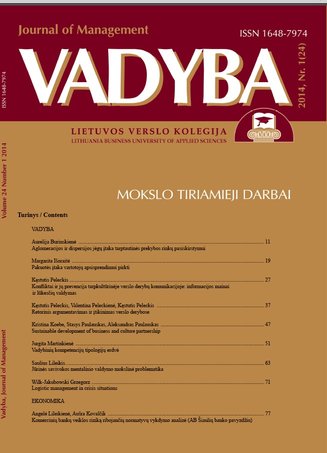AGLOMERACIJOS IR DISPERSIJOS JĖGŲ ĮTAKA TARPTAUTINĖS PREKYBOS RINKŲ PASISKIRSTYMUI
THE INFLUENCE OF AGGLOMERATION AND DISPERSION FORCES FOR THE DISTRIBUTION OF INTERNATIONAL TRADE MARKETS
Author(s): Aurelija BurinskienėSubject(s): Economy
Published by: Lietuvos verslo kolegija
Keywords: International trade; enterprise; industry; region; market:
Summary/Abstract: Among Lithuanian authors, international trade is researched as import and export activity mainly. Export and import is researched by Rakauskienė (2006); export and import regulatory measures are examined by Bernatonytė (2009); the commercial architecture of international trade, the main Lithuania export partners are analysed by Ginevičius and others (2005); Lithuanian exports structure and dynamics is presented by Purlys (2006); and the changes of export volumes are investigated by Jakutis and others (2005). However, the attention to economic activity concentration (agglomeration) is not very among Lithuanian researchers. On the other hand, the authors in world's scientific literature investigate the topic from different directions. International trade and the placement of economic activity are common topics in economic researches. One direction of researches stands for the tendency to agglomeration interpretation through international trade and input-output linkages between firms. Another direction turns to the effect of the internal market, as an agglomeration, international trade costs, and increasing returns to scale relationship analyzes. Third direction focuses on the compatibility of rising income and transportation costs and its effect to economic activity concentration. However, not all insights were based on models that allow to analyze the overall balance between explaining the placement of companies in the region. Crucial is Nobel laureate P. Krugman's contribution, which directly affected the international trade and geography field studies. The aim of the study – after the systematic analyze of scientific works dedicated to economic activity concentration topic to provide proposals, which focuses on international trade volume development. The survey is conducted on the basis of the knowledge accumulated in the scientific literature (the research is literature-driven). Systemic analysis methods, generalisation, concretizing, and comparison are used in the study. The systematic analyse is used in the paper seeking to research international trade as the complex object and to develop solutions used for the promotion of international trade volumes. In this paper agglomeration issues are analyzed in three different ways. First, the analysis of the industry life cycle stages in the content of the agglomeration effects is delivered. Second, in the article models, used for the analysis of agglomeration force, are presented. According references in literature models are grouped into five main categories: models dedicated for assortment diversity, market size, distance to the concentration regions ('major markets'); industry ups and downs, and other factors (variables). According P. Krugman New Economic Geography (NEG) models present that companies achieve better results, increase return of investments due to agglomeration force.
Journal: VADYBA
- Issue Year: 24/2014
- Issue No: 1
- Page Range: 11-18
- Page Count: 7
- Language: Lithuanian

